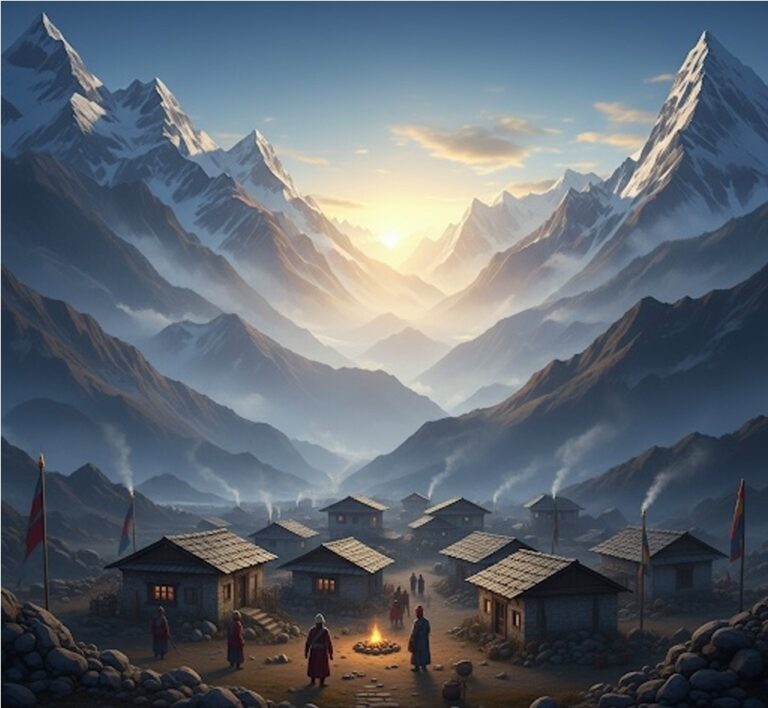Monsoon A Kaliedoscope of Colour
Every human being on the Indian subcontinent looks forward to the monsoon, which is still a seasonal occurrence. Monks, travellers, poets, traders, and scholars have long held it in high regard. Every person on the subcontinent has viewed it from their own point of view, and it is still the focus of heated, multifaceted discussion. Apart from shaping the subcontinent’s drainages and paleogeography, the monsoon has given numerous civilizations the wherewithal to survive. The development of the summer monsoon, which gave rise to rivers, crops, and human settlements, was greatly influenced by the growth of the Himalayas. The current synthesis of the monsoon demonstrates its connection to the evolution and history of human societies.
A monsoon is a seasonal shift in the predominant winds’ direction in a certain area. In most of the tropics, monsoons bring about both rainy and dry seasons. Most people identify monsoons with the Indian Ocean. The monsoon season always moves from cold to warm climates. The majority of India and Southeast Asia’s climate is influenced by the summer and winter monsoons.
The Summer Monsoon
There is a lot of rain during the summer monsoon. Typically, it takes place from April until September. Warm, humid air from the southwestern Indian Ocean pushes toward Bangladesh, Myanmar, Sri Lanka, and India as winter draws to a close. These regions have heavy rainfall and a humid environment during the summer monsoon.
Southeast Asia and India rely on the summer monsoon. For instance, agriculture depends on the annual rainfall. Large irrigation systems around lakes, rivers, and snowmelt areas are lacking in many parts of these nations. Aquifers are shallow subterranean water sources. Aquifers and wells are filled for the remainder of the year by the summer monsoon. Among the crops that depend on the summer monsoon are rice and tea. In order to keep cows healthy and nourished, dairy farms—which contribute to India’s status as the world’s largest milk producer—also rely on the monsoon rains. Hydroelectric power facilities in the area generate a significant amount of electricity using water collected during the monsoon season. Businesses, schools, and hospitals that support the growth of these communities’ economy are powered by electricity.
The economy of the region suffers when the summer monsoon is poor or delayed. Large agribusinesses lack produce to market, and fewer individuals are able to raise their own food. Food must be imported by governments. The rising cost of electricity can often restrict development to rich individuals and huge corporations.
It has been said that India’s genuine finance minister is the summer monsoon. Strong summer monsoons have the potential to do significant harm. In cities like Mumbai, India, residents are accustomed to the streets filling with over half a metre (1.5 feet) of water each summer. However, floods can wreak havoc on the area if the summer monsoon is more intense than anticipated. Entire communities may submerge in places like Mumbai.
Mudslides have the power to bury villages and ruin crops in rural regions.
Western India was hit by a powerful monsoon in 2005. Gujarat was initially affected by the summer monsoon, which swept in from the southwest. Over 100 individuals lost their lives. The state of Maharashtra was then struck by the monsoon rains. Over 1,000 people were killed by flooding in Maharashtra. Mumbai, Maharashtra, experienced over a metre (39.1 inches) of rain on July 26, 2005.
The Winter Monsoon
Compared to its wet summer counterpart, the Indian Oceans winter monsoon, which lasts from October to April, is less well-known. The northeast is the source of the dry winter monsoon. These winds originate over northwest China and Mongolia. Because the Himalaya Mountains block a large portion of the monsoon’s wind and moisture from reaching the shore, Southeast Asia’s winter monsoons are weaker than their summer counterparts. Additionally, the Himalayas keep regions like southern India and Sri Lanka warm throughout the year by blocking a large portion of the chilly air from getting there.
Droughts are occasionally linked to winter monsoons. But not every winter monsoon is dry. The rainy season occurs in the winter in Southeast Asia’s eastern, Pacific coast, in contrast to the region’s western region. Areas like Indonesia and Malaysia receive moist air from the South China Sea during the winter monsoon. Because the Himalaya Mountains block a large portion of the monsoon’s wind and moisture from reaching the shore, Southeast Asia’s winter monsoons are weaker than their summer counterparts.
Different Monsoons
From northern Australia to the Pacific coast of Russia, the Asian-Australian monsoon encompasses the Indian Ocean. The Indian Ocean is then reached by this massive monsoon wind system. On the African coast of India, everything finally comes to an end. There are monsoon winds elsewhere in the world. Typically occurring in the midst of summer, the North American monsoon occurs once a year. The Gulf of Mexico’s warm, humid air travels northwest, whereas the Gulf of California’s warm, humid air blows northeast.
In central Mexico, above the Sierra Madre Occidental mountains, these two winds converge. Before moving north to the U.S. states of Arizona, New Mexico, and Texas, the monsoon provides moisture to the mountain habitat. Firefighters may benefit naturally from the monsoon season in North America. Arizona frequently has summer temperatures above 100 degrees Fahrenheit, which makes it challenging to control wildfires. The majority of the region’s desert ecosystems rely on the North American monsoon as their main supply of water. For people and organisations who aren’t accustomed to coping with intense rain, it can also cause confusion and disruptions to their regular routine.
The monsoon season in India is a time of renewal and rejuvenation. The rains bring life to the parched earth, and the landscape transforms into a lush green oasis. The monsoon’s hues are a kaleidoscope of colors, from the deep greens of the forests to the vibrant hues of the flowers that bloom in the rain.
## Key Aspects:
1. Cultural Significance: Monsoons are celebrated in various festivals across India, showcasing the season’s importance in Indian culture.
2. Agricultural Importance: The monsoon rains are crucial for India’s agricultural sector, supporting the country’s food production.
3. Natural Beauty: The monsoon’s arrival brings forth a burst of colors, from the greenery of the forests to the vibrant hues of the flowers.
Mostly limited to the summer months of June through September, the Indian summer monsoon is a large-scale synoptic and dominating circulation phenomenon. The growth of water resources, the agriculture industry, and decision-making for developmental initiatives may all benefit from a thorough understanding of rainfall patterns and trends.
During the climatological era, the current study aims to assess the spatial variability in Indian summer monsoon rainfall (ISMR) over the Indian subcontinent (1901-2010). For the years 1901–2010, the long-term annual, decadal, and tricadal monsoon rainfall variations are taken into account during the monsoon season (June–September) and peak monsoon month (July-August).
The findings raise concerns for the main regions of Western India, the higher Himalaya, and the Indian peninsula, where reports of positive rainfall differences or increases of 0.2 to 1 mm/day have been made throughout the monsoon and peak monsoon months. Additionally, rainfall has been reported to have decreased by -0.6 to -1.5 mm/day throughout the Western Ghats, Indo-Gangetic Plain (IGP), and certain central Indian districts. Furthermore, a general review of the study indicates that ISMR has increased over Western India whereas it has significantly decreased over Northeast Indian areas, indicating a shift towards the west due to climate change.
The economy, agriculture, and the livelihoods of billions of people in South Asia are all greatly impacted by the Indian monsoon. The potential for separate subseasonal occurrences that are phase-locked in the Indian monsoon yearly cycle has received little attention, though. This work fills this gap by objectively classifying six different subseasonal phases based on the 850-hPa wind fields using the self-organizing map (SOM) approach.
Every subseasonal The three substages of the Indian summer monsoon (ISM)—the ISM-onset, ISM-peak, and ISM-withdrawal—combine to account for 82% of the yearly precipitation. From mid-May to early October, the three substages represent the southwesterlies’ swift northward advance, dominance, and slow southerly withdrawal. The three substages of the winter monsoon—fall, winter, and spring—are also distinguished by the hydrological conditions and the latitude of the Arabian Sea high pressure ridge.
In order to assess the winter and summer monsoons, respectively, this study suggests two compact indexes based on zonal winds in the northern and southern Arabian Sea. These indices, which may be utilised for subseasonal monsoon forecasting and monitoring, represent the evolution and reversals of the six SOM-derived phases. While the ISM-peak stage has the highest danger of flooding, the spring and ISM-onset occurrences are particularly vulnerable to the compound risks of heatwaves and droughts.
Tropical storms over the Arabian Sea and the Bay of Bengal peak during the autumn stage. The demarcation of the Indian monsoon subseasonal characteristics is supported by the strong correlation (0.6–0.8) between the yearly start and finish dates of the ISM-peak and the previously suggested criteria-based dates.
Although one of the most extensively studied aspects of hydrometeorology is Indian Summer Monsoon Rainfall (ISMR), little is known about the mechanisms underlying ISMR. This is a result of ISMR’s complexity over a variety of spatiotemporal scales.
Despite the fact that a large portion of South Asia’s population depends on the monsoon, this leads to significant discrepancies in the literature’s evaluation of the effects of global warming. We have pointed out that the ways in which various large-scale and regional elements impact ISMR at various timeframes are not well understood.
These effects are then reflected in India’s hydrology and water industry. Knowing where we stand in addressing the effects of climate change on ISMR is necessary so that policy-making procedures and water management techniques in India can adjust.







